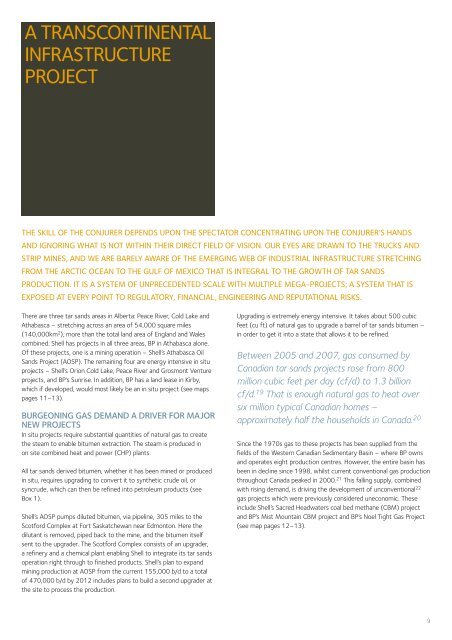bp and shell: rising risks in tar sands investments - Oil Change ...
bp and shell: rising risks in tar sands investments - Oil Change ...
bp and shell: rising risks in tar sands investments - Oil Change ...
Create successful ePaper yourself
Turn your PDF publications into a flip-book with our unique Google optimized e-Paper software.
A TRANSCONTINENTAL<br />
INFRASTRUCTURE<br />
PROJECT<br />
THE SKILL OF THE CONJURER DEPENDS UPON THE SPECTATOR CONCENTRATING UPON THE CONJURER’S HANDS<br />
AND IGNORING WHAT IS NOT WITHIN THEIR DIRECT FIELD OF VISION. OUR EYES ARE DRAWN TO THE TRUCKS AND<br />
STRIP MINES, AND WE ARE BARELY AWARE OF THE EMERGING WEB OF INDUSTRIAL INFRASTRUCTURE STRETCHING<br />
FROM THE ARCTIC OCEAN TO THE GULF OF MEXICO THAT IS INTEGRAL TO THE GROWTH OF TAR SANDS<br />
PRODUCTION. IT IS A SYSTEM OF UNPRECEDENTED SCALE WITH MULTIPLE MEGA-PROJECTS; A SYSTEM THAT IS<br />
EXPOSED AT EVERY POINT TO REGULATORY, FINANCIAL, ENGINEERING AND REPUTATIONAL RISKS.<br />
There are three <strong>tar</strong> s<strong>and</strong>s areas <strong>in</strong> Alberta: Peace River, Cold Lake <strong>and</strong><br />
Athabasca – stretch<strong>in</strong>g across an area of 54,000 square miles<br />
(140,000km 2 ), more than the total l<strong>and</strong> area of Engl<strong>and</strong> <strong>and</strong> Wales<br />
comb<strong>in</strong>ed. Shell has projects <strong>in</strong> all three areas, BP <strong>in</strong> Athabasca alone.<br />
Of these projects, one is a m<strong>in</strong><strong>in</strong>g operation – Shell’s Athabasca <strong>Oil</strong><br />
S<strong>and</strong>s Project (AOSP). The rema<strong>in</strong><strong>in</strong>g four are energy <strong>in</strong>tensive <strong>in</strong> situ<br />
projects – Shell’s Orion Cold Lake, Peace River <strong>and</strong> Grosmont Venture<br />
projects, <strong>and</strong> BP’s Sunrise. In addition, BP has a l<strong>and</strong> lease <strong>in</strong> Kirby,<br />
which if developed, would most likely be an <strong>in</strong> situ project (see maps<br />
pages 11–13).<br />
BURGEONING GAS DEMAND A DRIVER FOR MAJOR<br />
NEW PROJECTS<br />
In situ projects require substantial quantities of natural gas to create<br />
the steam to enable bitumen extraction. The steam is produced <strong>in</strong><br />
on site comb<strong>in</strong>ed heat <strong>and</strong> power (CHP) plants.<br />
All <strong>tar</strong> s<strong>and</strong>s derived bitumen, whether it has been m<strong>in</strong>ed or produced<br />
<strong>in</strong> situ, requires upgrad<strong>in</strong>g to convert it to synthetic crude oil, or<br />
syncrude, which can then be ref<strong>in</strong>ed <strong>in</strong>to petroleum products (see<br />
Box 1).<br />
Shell’s AOSP pumps diluted bitumen, via pipel<strong>in</strong>e, 305 miles to the<br />
Scotford Complex at Fort Saskatchewan near Edmonton. Here the<br />
dilutant is removed, piped back to the m<strong>in</strong>e, <strong>and</strong> the bitumen itself<br />
sent to the upgrader. The Scotford Complex consists of an upgrader,<br />
a ref<strong>in</strong>ery <strong>and</strong> a chemical plant enabl<strong>in</strong>g Shell to <strong>in</strong>tegrate its <strong>tar</strong> s<strong>and</strong>s<br />
operation right through to f<strong>in</strong>ished products. Shell’s plan to exp<strong>and</strong><br />
m<strong>in</strong><strong>in</strong>g production at AOSP from the current 155,000 b/d to a total<br />
of 470,000 b/d by 2012 <strong>in</strong>cludes plans to build a second upgrader at<br />
the site to process the production.<br />
Upgrad<strong>in</strong>g is extremely energy <strong>in</strong>tensive. It takes about 500 cubic<br />
feet (cu ft) of natural gas to upgrade a barrel of <strong>tar</strong> s<strong>and</strong>s bitumen –<br />
<strong>in</strong> order to get it <strong>in</strong>to a state that allows it to be ref<strong>in</strong>ed.<br />
Between 2005 <strong>and</strong> 2007, gas consumed by<br />
Canadian <strong>tar</strong> s<strong>and</strong>s projects rose from 800<br />
million cubic feet per day (cf/d) to 1.3 billion<br />
cf/d. 19 That is enough natural gas to heat over<br />
six million typical Canadian homes –<br />
approximately half the households <strong>in</strong> Canada. 20<br />
S<strong>in</strong>ce the 1970s gas to these projects has been supplied from the<br />
fields of the Western Canadian Sedimen<strong>tar</strong>y Bas<strong>in</strong> – where BP owns<br />
<strong>and</strong> operates eight production centres. However, the entire bas<strong>in</strong> has<br />
been <strong>in</strong> decl<strong>in</strong>e s<strong>in</strong>ce 1998, whilst current conventional gas production<br />
throughout Canada peaked <strong>in</strong> 2000. 21 This fall<strong>in</strong>g supply, comb<strong>in</strong>ed<br />
with <strong>ris<strong>in</strong>g</strong> dem<strong>and</strong>, is driv<strong>in</strong>g the development of unconventional 22<br />
gas projects which were previously considered uneconomic. These<br />
<strong>in</strong>clude Shell’s Sacred Headwaters coal bed methane (CBM) project<br />
<strong>and</strong> BP’s Mist Mounta<strong>in</strong> CBM project <strong>and</strong> BP’s Noel Tight Gas Project<br />
(see map pages 12–13).<br />
9




![[2007] EWHC 311 - Greenpeace UK](https://img.yumpu.com/22079793/1/184x260/2007-ewhc-311-greenpeace-uk.jpg?quality=85)












